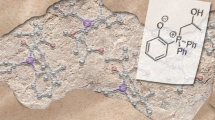Summary
A series of dioxouranium(VI) complexes of the type UO2L2X2, where L=bidentate Schiff base, derived fromp-chloroaniline,o-anisidine,o-toluidine andp-phenitidine with 2-hydroxy-1-naphthaldehyde and X−=Cl−, Br−, I−, NCS−, NO −3 , OAc− or 0.5 SO 2−4 have been synthesized and characterized. P.m.r. data point out that only the unionized form of the Schiff base is involved in bonding with uranyl ion. The i.r. evidence supports this observation and also shows that the thiocyanato group is actuallyN-bonded, the nitrato group is unidentately bonded and the sulphato group is bonded covalently in a bidentate manner. The coordination number of uranium is eight.
Similar content being viewed by others
References
P. Pfeiffer, E. Breith, E. Lubbe and T. Tsumaki,Ann. Chem., 84, 503 (1933).
L. Sacconi and G. Giannoni,J. Chem. Soc., 2751 (1954);Ibid, 2368 (1954).
I. A. Savich, A. K. Pikaev, V. G. Lebedov and V. I. Spitsyn,Zh. Neorg. Khim., 1, 2736 (1956).
R. H. Holm, G. W. Everett, Jr. and A. Chakravorty,Progr. Inorg. Chem., 7, 83 (1966).
S. Yamada and A. Takeuchi,Bull. Chem. Soc. Jpn., 42, 2549 (1969).
L. Cattalini, S. Degetto, M. Vidall and P. A. Vigato,Inorg. Chim. Acta, 6, 173 (1972).
L. Doretti, S. Sitran, S. Faleschini, F. Madalosso and G. Faraglia,J. Inorg. Nucl. Chem., 38, 2123 (1976).
H. Mohanta and K. C. Dash,Indian J. Chem., 15A, 657 (1977).
H. Mohanta and K. C. Dash,J. Inorg. Nucl. Chem., 39, 1345 (1977).
G. Dia, V. Luparello, F. Maggio, T. Pizzino, V. Romano and G. Bocchi,Inorg. Nucl. Chem. Lett., 16, 109 (1980).
L. Doretti, S. Sitran, F. Madalosso, G. Bandeli and G. Paolucci,J. Inorg. Nucl. Chem., 42, 1060 (1980).
I. Fankuchen,Z. Kristallogr., 91, 473 (1935).
K. Uneo and A. E. Martell,J. Phys. Chem., 59, 998 (1955).
D. Brown,Halides of the Lanthanides and Actinides, Wiley-Interscience, New York, 1968, p. 211.
I. S. Isapkina and G. V. Ellert,Russ. J. Inorg. Chem., 13, 730 (1968).
G. K. T. Conn and C. K. Wu,Trans. Faraday Soc.,34, 1483 (193).
K. W. Bagnall and M. W. Wakerley,J. Less-common Mets., 35, 267 (1968).
F. A. Cotton in J. Lewis and R. G. Wilkins (Eds.),The Infrared Spectra of Transition Metal Complexes, inModern Coordination Chemistry, Interscience, New York, 1960, p. 310.
E. P. Bertin, R. B. Penland, S. Mizushima, C. Curran and J. V. Quagliano,J. Am. Chem. Soc., 81, 3818 (1959); J. E. Fleming and H. Lynton,Chem. Ind. (London), 1416 (1963); C. C. Addison and W. B. Simpson,J. Chem. Soc., 598 (1965); A. B. P. Lever,Inorg. Chem., 4, 1042 (1965).
C. C. Addison and D. Sutton,Progr. Inorg. Chem., 8, 196 (1967).
E. P. Hertzenberg and J. C. Bailar,Inorg. Chem., 10, 2371 (1971).
Author information
Authors and Affiliations
Rights and permissions
About this article
Cite this article
Rajaram, V., Paulraj, K. & Ramalingam, S.K. Dioxouranium(VI) complexes of some bidentate Schiff bases. Transition Met Chem 8, 335–337 (1983). https://doi.org/10.1007/BF00618565
Received:
Issue Date:
DOI: https://doi.org/10.1007/BF00618565




